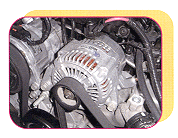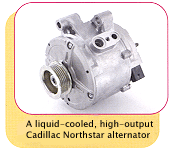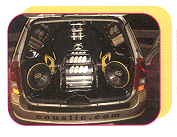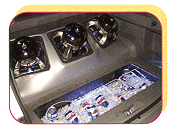It takes a lot of amps to power the lights, electric defrosters, wipers, power windows, power seats, power liftgates, the ignition system, fuel injectors, fuel pump, cooling fan, A/C compressor, heater fan, heated seats, audio system and navigation systems on today’s late-model vehicles. Since alternators can generate only so many amps, their output may depend on engine speed.
 Cramping the Cranking Loads
Cramping the Cranking Loads
At idle, when the alternator is turning slowly, output is reduced and may not be able to keep up with the demands on the charging system. Consequently, the battery has to make up the difference. The reserve capacity of the battery is like a bank account. It stores amps so that the electrical system can withdraw amps when electrical loads exceed the charging system’s output. Cranking the engine pulls amps out of the battery. So do high electrical loads when the engine is idling. The amps are put back into the battery when the vehicle is driven and the charging system is able to generate more amps than what are needed to keep things running.
Trouble is, the vehicle may not be driven long enough to make up the difference. Short trips of 15 minutes or less ‹ especially in stop-and-go traffic ‹ may not be enough to keep the battery fully charged. This may cause hard starting or a no-start condition if the battery doesn’t have enough power to crank the engine ‹ especially during cold weather. Chronic undercharging also can shorten battery life by allowing the battery plates to become sulfated. And low voltage can play havoc with onboard electronics, and the fuel injection and ignition systems.
 In addition, high loads on the charging system are hard on the alternator and may cause premature alternator failure. Alternators run hot, and the higher the amp load on the charging system, the higher the internal operating temperature of the alternator. Stock alternators should be capable of handling normal amperage loads under normal operating conditions. But vehicles that spend a lot of time idling, or are driven for only short distances or mostly at night may tax the alternator to its design limit. And when other aftermarket accessories are installed on a vehicle, such as a killer sound system or auxiliary lighting, it may create a higher load than the stock alternator can handle.
In addition, high loads on the charging system are hard on the alternator and may cause premature alternator failure. Alternators run hot, and the higher the amp load on the charging system, the higher the internal operating temperature of the alternator. Stock alternators should be capable of handling normal amperage loads under normal operating conditions. But vehicles that spend a lot of time idling, or are driven for only short distances or mostly at night may tax the alternator to its design limit. And when other aftermarket accessories are installed on a vehicle, such as a killer sound system or auxiliary lighting, it may create a higher load than the stock alternator can handle.
Taking it to the Extreme
Teenagers and twenty-somethings love loud music. The louder the beat, the better. They wanna feel the music. Megawatt amplifiers and a trunk full of subwoofers can crank out more decibels than a 747 jumbo jet during take-off. “Boom cars” may annoy some people, even yourself. But to those who drive these rolling sound platforms, amps are like horsepower. They can’t get enough. In fact, there now are groups all across the country who are into decibel (dBA) drag racing and spending thousands of dollars on high-output sound systems and charging system upgrades to power the audio equipment. The basic objective of a dBA drag racing event is to see who can make the most noise. Sound levels are measured with an SPL meter placed inside the vehicle. The SPL meter’s microphone converts sound waves into a voltage signal that is processed and displayed as a decibel reading. The sound levels that are being recorded at many of these events are often in excess of 130 dBA, with some going almost as high as 170 dBA!
Powering Up
As audio output goes up, so does the energy required to produce the sound waves. It takes about 16 amps of electrical power for every 100 watts of audio output. If a vehicle is equipped with a 100-watt amplifier, the stock alternator can therefore easily handle the 16 amps needed to power the sound system. But if it has a 500-watt system, it will pull more than fives times as much juice from the charging system (80 amps) when the driver cranks up the volume. At that level, the load may exceed the amp rating of the stock alternator. If the vehicle has a 1,000-watt system, the charging system will have to produce 160 amps to keep the decibels pumping ‹ which is way more than any stock alternator can produce.
 It takes power to make power, and for every 25 amps that an alternator produces, it saps about one horsepower from the engine to drive it. A stock 100-amp alternator running at maximum output will need about four horsepower from the engine. If the vehicle is equipped with two or even three high-output 200-amp alternators, the charging system may need 18 to 24 horsepower at peak output.
It takes power to make power, and for every 25 amps that an alternator produces, it saps about one horsepower from the engine to drive it. A stock 100-amp alternator running at maximum output will need about four horsepower from the engine. If the vehicle is equipped with two or even three high-output 200-amp alternators, the charging system may need 18 to 24 horsepower at peak output.
Another rule of thumb is that alternator output should equal about 25% of the vehicle’s total battery capacity. A dBA racer with a 400 amp-hour battery pack would need at least a 100-amp alternator to keep his batteries charged. For continuous charging, the alternator’s output should be 150% of maximum load.
Addressing Customer Needs
Decibel drag racing is obviously an extreme example of the demands that can be placed on a charging system. The charging needs of the average motorist you’re likely to encounter will be far less than those for extreme audio events, but they may exceed the output of their stock alternators.
There are a growing number of everyday applications that can benefit from upgraded charging systems. One such application would be trucks and SUVs that are used for off-roading and are equipped with mega candlepower off-road lighting.
 Another would be vehicles equipped with snow plows. The current drawn by the auxiliary lights may be more than the stock alternator can safely handle. For these kinds of applications, replacing the stock alternator with a high-output alternator may keep the lights burning brightly and prevent premature alternator failures.
Another would be vehicles equipped with snow plows. The current drawn by the auxiliary lights may be more than the stock alternator can safely handle. For these kinds of applications, replacing the stock alternator with a high-output alternator may keep the lights burning brightly and prevent premature alternator failures.
Another application for high-output alternators is emergency vehicles. Any vehicle that is equipped with emergency lighting and communications equipment can place a high load on the charging system at idle when the special equipment is being used. Under these conditions, the stock alternator may not hold up very well. Alternators in many police vehicles last only about a year. Upgrading to a higher-output alternator can help the alternator last longer while providing the extra amps that may be needed when electrical loads are high.
Preventing Repeat Failures
When an alternator fails, what do you do? Replace it with a new or remanufactured unit? Hopefully, you install an alternator that has the same or higher amp rating as the original. Higher is often better, especially when a vehicle has a high-wattage audio system, auxiliary lighting or other amp-hungry accessories. If it seems likely that high amp loads on the charging system caused the original alternator to fail, you should recommend installing a higher-output replacement alternator. A high-output alternator will cost more, but it should save your customer money in the long run by extending alternator and battery life.
High-output alternators are available from a number of suppliers. Some are brand new units, while others are remanufactured units that have been rewound to produce more amps. High-output units are typically rated at 140 to 225 amps. The better units can produce 70 to 100 amps at idle, which is double the output of most stock alternators.
 Higher outputs are achieved by rewinding the stators and rotors, tightening up clearances and using an undersize pulley to spin the alternator faster. This really helps at idle, and boosts the charging output throughout the rpm range. Most have heavy-duty diodes that can handle more current and heat, and better bearings to improve durability. Some also have special heat-resistant ceramic coatings and insulation on critical parts. Chrome-plated, anodized and brightly painted housings are also available for those who want to dress-up their engine compartment.
Higher outputs are achieved by rewinding the stators and rotors, tightening up clearances and using an undersize pulley to spin the alternator faster. This really helps at idle, and boosts the charging output throughout the rpm range. Most have heavy-duty diodes that can handle more current and heat, and better bearings to improve durability. Some also have special heat-resistant ceramic coatings and insulation on critical parts. Chrome-plated, anodized and brightly painted housings are also available for those who want to dress-up their engine compartment.
Installation Advice
Some of these units are direct bolt-on replacements for the OEM alternator. Others require some modifications to install (changing or relocating brackets and splicing wires). In either case, the wiring harness that handles the alternator’s output must be beefed up with heavier-gauge wiring. Use 2GA wiring for 120- to 140-amp alternators, and 1/0GA wiring for 140- to 225-amp alternators. Some suppliers of high-output alternators provide an upgraded wiring harness with their alternator ‹ and won’t honor their warranty unless the wiring harness is also installed with the alternator.
Maintaining Charge
Most charging systems that are working properly should produce a charging voltage of about 13.8 to 14.2 volts at idle with the lights and accessories off. Always refer to the vehicle manufacturer’s specifications. Many Asian vehicles, for example, have higher charging voltages of around 15 volts. When the engine is first started, the charging voltage should rise quickly to about two volts above base battery voltage, then taper off, leveling out at the specified voltage.
The exact charging voltage will vary according to the battery’s state of charge, the load on the vehicle’s electrical system and temperature. The lower the temperature the higher the charging voltage, and the higher the temperature the lower the charging voltage. The “normal” charging voltage on a typical application might be 13.9 to 15.1 volts at 77° F. But at 20° F below zero, the charging voltage might be 14.9 to 15.8 volts. On a hot engine on a hot day, the normal charging voltage might drop to 13.5 to 14.3 volts.
Charging output also can be checked with an adjustable carbon pile voltmeter and ampmeter. The carbon pile is attached to the battery and adjusted to obtain maximum output while the engine is running at 2,000 rpm. Charging amperage is another number that can reveal the condition of the alternator. With the engine idling and no load on the charging system (lights and all accessories off, and battery fully charged), the amperage output should be relatively low (typically less than 10 amps). With the headlights and heater blower fan on and the engine running at 2,000 rpm, the output should jump to a higher reading, typically 25 to 30 amps or more. Another way to check alternator output is with an oscilloscope. Observing the “ripple voltage” pattern will tell you at a glance whether or not all the alternator windings are functioning. A “good” pattern should look like the top of a picket fence. If any of the humps are missing, it means one or more of the windings is grounded or open, or there’s a bad diode. Most battery/ charging system testers also have a test function that can detect bad diodes.
One way to check the integrity of the alternator and diodes on certain alternators, for example, is to check the voltage readings at the D+ (blue wire) terminal and B+ terminal. The voltage reading should be the same at both terminals. A difference of more than one volt would indicate faulty diodes and the need to replace the alternator.
One alternator manufacturer doesn’t recommend full fielding as a procedure for testing alternator output because full fielding may damage onboard electronics.
|
What Did You Say?
Won’t all those decibels damage these driver’s hearing? Heck Yes! Noise levels above 115 dBA for any period of time can cause permanent hearing damage. Prolonged exposure to noise levels above 90 dBA (which is the OSHA limit for an eight-hour workshift for shop employees) can even cause hearing loss. So, the irony here is that many of these people who enjoy such loud music will probably go deaf as a result of their audio overindulgence. |
|
Crank It Up
Racing isn’t just about speed anymore. People across the country are spending thousands of dollars on high-output sound systems and charging system upgrades, all in an attempt to win in decibel (dBA) drag racing competitions. For extreme audio enthusiasts, 500 watts is too wimpy to even consider. Some of the most competitive vehicles are loaded with racks of amplifiers that pump out tens of thousands of watts because that’s what it takes to win a dBA drag racing event. For this level of output, additional batteries and high-discharge capacitors are needed to supply up to 30 seconds of peak supplemental power. Marine batteries are usually preferred because they can handle deep discharge cycles and have high amp-hour ratings (85 to 105 is typical). A rule of thumb for dBA racers is one extra battery for every 500 watts of audio output. Rules for dBA drag racing vary depending on the class of vehicle. For “Street” vehicles, the limit is one alternator (any output). For “Super Street,” it’s two alternators, and for the “Extreme” class any number of alternators can be used. For more details on this sport, visit the “dBA Drag Racing” website at www.termpro.com. WARNING: Never disconnect a battery cable while the engine is running to “test” the alternator. Doing so can cause high voltage spikes that can damage the alternator as well as other electronics. |




